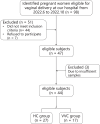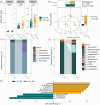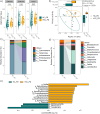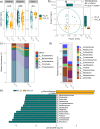Alterations of the paired maternal vaginal microbiome and neonatal meconium microbiome in vulvovaginal candidiasis positive pregnant women
- PMID: 39735259
- PMCID: PMC11673766
- DOI: 10.3389/fcimb.2024.1480200
Alterations of the paired maternal vaginal microbiome and neonatal meconium microbiome in vulvovaginal candidiasis positive pregnant women
Abstract
Background: Women with vulvovaginal candidiasis (VVC) are known to experience vaginal microbial dysbiosis. However, the dynamic alterations of the vaginal microbiome in pregnant women with VVC and its effect on neonatal gut microbiome remain unclear. This study aims to characterize the vaginal microbiome in pregnant women with VVC and its impact on their offspring's meconium microbiome.
Methods: Forty-four pregnant women, including 17 with VVC (VVC group) and 27 healthy controls (HC group), along with their 44 offspring, were enrolled in this study. Maternal vaginal samples were collected during the pre- and post-delivery phases. Meconium samples from their newborns were also obtained. Microbial communities were characterized using 16S rRNA sequencing.
Results: The vaginal microbiome of healthy pregnant women was predominantly composed of the genus Lactobacillus. The Bray-Curtis dissimilarity index indicated significant alterations in the vaginal microbiome of the VVC group, with a notable decrease in Lactobacillus and significant increases in Delftia, Burkholderia during both the pre- and post-delivery phases compared to the HC group. Additionally, the neonatal meconium microbiome exhibited significant differences between the VVC and HC groups, with L. salivarius and L. helveticus significantly decreased and Delftia significantly increased in the VVC group. Similar trends in microbial variation were observed across maternal and neonatal microbiomes, indicating intergenerational concordance associated with VVC.
Conclusion: VVC alters the microbiota of both pregnant women and their neonates at birth, suggesting a form of microbial inheritance. These findings underscore the distinctive characteristics of the vaginal microbiome associated with VVC and its potential impact on the formation of early-life gut microbiome.
Keywords: genital infection; meconium microbiome; microbial community; vaginal microbiome; vulvovaginal candidiasis.
Copyright © 2024 Zhang, Li, Zhang, Ji, Chen, Nie and Huang.
Conflict of interest statement
The authors declare that the research was conducted in the absence of any commercial or financial relationships that could be construed as a potential conflict of interest.
Figures





Similar articles
-
Perinatal Antibiotic Exposure Affects the Transmission between Maternal and Neonatal Microbiota and Is Associated with Early-Onset Sepsis.mSphere. 2020 Feb 19;5(1):e00984-19. doi: 10.1128/mSphere.00984-19. mSphere. 2020. PMID: 32075882 Free PMC article.
-
Diverse vaginal microbiomes in reproductive-age women with vulvovaginal candidiasis.PLoS One. 2013 Nov 12;8(11):e79812. doi: 10.1371/journal.pone.0079812. eCollection 2013. PLoS One. 2013. PMID: 24265786 Free PMC article.
-
Vaginal microbiota of asymptomatic bacterial vaginosis and vulvovaginal candidiasis: Are they different from normal microbiota?Microb Pathog. 2019 Sep;134:103599. doi: 10.1016/j.micpath.2019.103599. Epub 2019 Jun 15. Microb Pathog. 2019. PMID: 31212037
-
Vulvovaginal candidiasis and vaginal microflora interaction: Microflora changes and probiotic therapy.Front Cell Infect Microbiol. 2023 Feb 3;13:1123026. doi: 10.3389/fcimb.2023.1123026. eCollection 2023. Front Cell Infect Microbiol. 2023. PMID: 36816582 Free PMC article. Review.
-
Microbiome structure in healthy and pregnant women and importance of vaginal dysbiosis in spontaneous abortion.Front Cell Infect Microbiol. 2025 Feb 17;14:1401610. doi: 10.3389/fcimb.2024.1401610. eCollection 2024. Front Cell Infect Microbiol. 2025. PMID: 40046910 Free PMC article. Review.
References
MeSH terms
Substances
LinkOut - more resources
Full Text Sources

